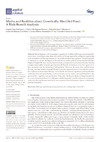Please use this identifier to cite or link to this item:
https://accedacris.ulpgc.es/jspui/handle/10553/114256
| DC Field | Value | Language |
|---|---|---|
| dc.contributor.author | Vega Rodríguez, Angelo | en_US |
| dc.contributor.author | Rodríguez Oramas, Cristina Isabel | en_US |
| dc.contributor.author | Sanjuán Velázquez, Esther | en_US |
| dc.contributor.author | de la Torre, Arturo Hardisson | en_US |
| dc.contributor.author | Armendáriz, Carmen Rubio | en_US |
| dc.contributor.author | Carrascosa Iruzubieta, Conrado Javier | en_US |
| dc.date.accessioned | 2022-03-30T07:22:41Z | - |
| dc.date.available | 2022-03-30T07:22:41Z | - |
| dc.date.issued | 2022 | en_US |
| dc.identifier.issn | 2076-3417 | en_US |
| dc.identifier.other | Scopus | - |
| dc.identifier.uri | https://accedacris.ulpgc.es/handle/10553/114256 | - |
| dc.description.abstract | The development and consumption of genetically modified (GM) crops are surrounded by controversy. According to proponents, only molecular biology approaches and genetic engineering tools are realistic food shortage solutions for the world’s ever-growing population. The main purpose of this study is to review the impact of GM products on human, animal, and environmental health. People still reject GM crops not only because of safety concerns, but also for moral reasons. Toxicity, allergies, and possible horizontal gene transfer (HGT) to the environment or to other species have been associated with the marketing of GM products. Moreover, the scarce data available about the long-term implications of using GM crops is another opponent concern. Nevertheless, science has evidenced no harm from GM crops use to date but has, instead, reported several benefits that result from their commercialization, such as economic, environmental, and health benefits for the general public. Legislation and policies about GM product labeling standards are being discussed. To overcome emerging food security challenges, considering quality scientific information is essential rather than leaving the issue and merely moving toward moral discussion. Hence, a risk–benefit analysis is necessary. | en_US |
| dc.language | eng | en_US |
| dc.relation.ispartof | Applied Sciences (Basel) | en_US |
| dc.source | Applied Sciences (Switzerland) [EISSN 2076-3417], v. 12 (6), (Marzo 2022) | en_US |
| dc.subject | 330915 Higiene de los alimentos | en_US |
| dc.subject.other | Food Security | en_US |
| dc.subject.other | Genetic Engineering | en_US |
| dc.subject.other | Gm Crops | en_US |
| dc.subject.other | Labeling | en_US |
| dc.subject.other | Legal Framework | en_US |
| dc.title | Myths and Realities about Genetically Modified Food: A Risk-Benefit Analysis | en_US |
| dc.type | info:eu-repo/semantics/article | en_US |
| dc.type | Article | en_US |
| dc.identifier.doi | 10.3390/app12062861 | en_US |
| dc.identifier.scopus | 85126325052 | - |
| dc.contributor.orcid | NO DATA | - |
| dc.contributor.orcid | NO DATA | - |
| dc.contributor.orcid | NO DATA | - |
| dc.contributor.orcid | NO DATA | - |
| dc.contributor.orcid | NO DATA | - |
| dc.contributor.orcid | NO DATA | - |
| dc.contributor.authorscopusid | 57486644900 | - |
| dc.contributor.authorscopusid | 57487144600 | - |
| dc.contributor.authorscopusid | 57487144700 | - |
| dc.contributor.authorscopusid | 8857406700 | - |
| dc.contributor.authorscopusid | 55806970800 | - |
| dc.contributor.authorscopusid | 55243552300 | - |
| dc.identifier.eissn | 2076-3417 | - |
| dc.identifier.issue | 6 | - |
| dc.relation.volume | 12 | en_US |
| dc.investigacion | Ciencias de la Salud | en_US |
| dc.type2 | Artículo | en_US |
| dc.description.numberofpages | 24 | en_US |
| dc.utils.revision | Sí | en_US |
| dc.date.coverdate | Marzo 2022 | en_US |
| dc.identifier.ulpgc | Sí | en_US |
| dc.contributor.buulpgc | BU-VET | en_US |
| dc.description.sjr | 0,492 | |
| dc.description.jcr | 2,7 | |
| dc.description.sjrq | Q2 | |
| dc.description.jcrq | Q2 | |
| dc.description.scie | SCIE | |
| dc.description.miaricds | 10,5 | |
| item.grantfulltext | open | - |
| item.fulltext | Con texto completo | - |
| crisitem.author.dept | GIR IUSA-ONE HEALTH 2 - Sanidad Animal de la Acuicultura y Especies Silvestres, Enfermedades Infecciosas y Seguridad Alimentaria | - |
| crisitem.author.dept | IU de Sanidad Animal y Seguridad Alimentaria | - |
| crisitem.author.dept | GIR OHAPA (Higiene y Protección Alimentaria) Grupo de Investigación | - |
| crisitem.author.dept | Departamento de Patología Animal, Producción Animal, Bromatología y Tecnología de Los Alimentos | - |
| crisitem.author.dept | GIR OHAPA (Higiene y Protección Alimentaria) Grupo de Investigación | - |
| crisitem.author.dept | Departamento de Patología Animal, Producción Animal, Bromatología y Tecnología de Los Alimentos | - |
| crisitem.author.orcid | https://orcid.org/0000-0002-3094-6492 | - |
| crisitem.author.orcid | 0000-0002-4789-8124 | - |
| crisitem.author.orcid | 0000-0003-2802-7873 | - |
| crisitem.author.parentorg | IU de Sanidad Animal y Seguridad Alimentaria | - |
| crisitem.author.parentorg | Departamento de Patología Animal, Producción Animal, Bromatología y Tecnología de Los Alimentos | - |
| crisitem.author.parentorg | Departamento de Patología Animal, Producción Animal, Bromatología y Tecnología de Los Alimentos | - |
| crisitem.author.fullName | Rodríguez Oramas,Cristina Isabel | - |
| crisitem.author.fullName | Sanjuán Velázquez, Esther | - |
| crisitem.author.fullName | Carrascosa Iruzubieta, Conrado Javier | - |
| Appears in Collections: | Artículos | |
SCOPUSTM
Citations
49
checked on Jun 8, 2025
WEB OF SCIENCETM
Citations
36
checked on Jun 8, 2025
Page view(s)
152
checked on Dec 16, 2023
Download(s)
72
checked on Dec 16, 2023
Google ScholarTM
Check
Altmetric
Share
Export metadata
Items in accedaCRIS are protected by copyright, with all rights reserved, unless otherwise indicated.
